Magic Quadrant for Operational Database
Management Systems
Published: 22 October 2018 ID: G00346575
Analyst(s): Merv Adrian, Donald Feinberg, Nick Heudecker
Data and analytics leaders evaluating OPDBMS options must balance
current and future needs in an increasingly competitive market. Nonrelational
and cloud-based vendors offer new opportunities for global enterprises,
which can use this Magic Quadrant to make better modernization choices.
Strategic Planning Assumptions
By 2019, separation of storage and compute resources designed for cloud DBMS architectures will
become the dominant database platform as a service (dbPaaS) model and will also start appearing
on-premises.
By 2020, open-source-based DBMS products will account for more than 20% of DBMS revenue,
which will increase their attractiveness to mainstream buyers.
Through 2020, relational technology will continue to be used for at least 70% of new applications
and projects.
By 2023, 75% of all databases will be on a cloud platform — a development that will drastically
change the DBMS vendor landscape.
Market Definition/Description
The operational database management system (OPDBMS) market is defined by relational and
nonrelational database management products suitable for the traditional transactions used to
support business processes. These include a broad range of enterprise-level applications — both
purchased business applications, such as ERP and CRM applications, and custom-made
transactional systems. Our definition of this market also includes DBMS products that support
interactions and event processing (data in motion) uses for the Internet of Things (IoT). (For
Gartner’s use of the term “nonrelational DBMS,” see Note 1. For our definition of an OPDBMS
workload, see Note 2.)
Gartner defines a DBMS as a complete software system used to define, create, update, manage
and query a database. The term “database” here refers to an organized collection of data that may
�
consist of multiple formats and be stored in some form of storage medium (which can include hard-
disk drives, flash memory, solid-state drives and DRAM). A database must include mechanisms to
isolate and manage workload requirements and control various parameters of end-user access
within managed instances of the data. Additionally, a DBMS should provide interfaces to
independent programs and tools, and permit and govern the performance of a variety of concurrent
workload types. There is no presupposition that a DBMS must support the relational model or the
full set of possible data types in use today. Further, our definition does not stipulate that the DBMS
must be a closed-source product; commercially supported open-source DBMS products are
included.
OPDBMSs may support multiple different delivery models, such as stand-alone DBMS software,
cloud (public and private) images or containerized versions, certified configurations and database
appliances (see Note 3). These are discussed and evaluated together in the analysis of each vendor.
In this Magic Quadrant, we treat all of a vendor’s OPDBMS products as a set. If a vendor markets
more than one DBMS product that can be used as an OPDBMS, we describe them in the section
specific to that vendor, but we evaluate all of that vendor’s products together as a single entity. If
any Strengths and Cautions relate to a specific offering or offerings, this is noted in the individual
vendor sections. It may be important for organizations to evaluate separate vendors’ offerings as
the range of choices becomes broader and as purchasers more frequently pursue best-of-breed
strategies. In the accompanying “Critical Capabilities for Operational Database Management
Systems,” individual products are assessed in terms of defined use cases and capabilities.
Page 2 of 37
Gartner, Inc. | G00346575
�
Magic Quadrant
Figure 1. Magic Quadrant for Operational Database Management Systems
Source: Gartner (October 2018)
Gartner, Inc. | G00346575
Page 3 of 37
�
Vendor Strengths and Cautions
Actian
Actian, which is headquartered in Palo Alto, California, U.S., offers Actian X Hybrid Database for
combined operational and analytical processing, NoSQL Object Database and Zen Embedded
Database by subscription-based and perpetual licensing. Actian X began shipping in April 2017 as a
free upgrade to Ingres, which is nearly four decades old. Half of the Ingres customer base is
European. A managed service is available, but no database platform as a service (dbPaaS).
Strengths
■
Loyal customers: Most of the Actian reference customers we surveyed had been using Ingres
for over 10 years. Its low maintenance requirement was singled out as a key reason for this.
Ingres is the standard DBMS in half of Actian’s reference customers.
■ Renewed product investment: Actian X Hybrid Database combines Ingres with the X100
engine of Actian’s Vector offering to create a real-time updatable column store with features
such as single instruction, multiple data (SIMD) vector processing, chip cache exploitation, and
automatic storage indexes for reducing I/O. In addition, Actian partners with Esri, Safe Software
and others to enhance its spatial tools.
■
Suitability of Zen for edge and IoT uses: Actian Zen Embedded Database is a purpose-built
self-tuning, zero database administrator (DBA) offering with multiple licensing models. In
addition to Windows and Linux, it supports Android, Raspbian, Windows 10 IoT Core and Nano
Server. Instances can share data without extraction, transformation and loading (ETL), and
DataConnect data integration ties Zen devices and Zen gateways to Vector and Actian X to
create end-to-end data flows.
Cautions
■
Lateness of key enterprise features and multimodel support: Online patching is not
possible, nor are Java stored procedures. There is no continuous statistics collection or
continuous tuning, and Actian has not yet begun to create internal machine learning (ML)-based
optimization. Synchronization of the in-memory column store requires the creation of triggers
and stored procedures. As yet, there is no document support via JavaScript Object Notation
(JSON) or XML, graph or linked data types. This will make it difficult for Actian to capture the
new workloads that are behind much new business.
■ Customer dissatisfaction: Actian received several survey sentiment scores greater than one
standard deviation (STD) below the mean, including for value, negotiation, overall product
capabilities, integration and deployment, and service and support. Respondents singled out
cloud/hybrid deployment, high availability/disaster recovery (HA/DR), automated data
distribution, and gaps in security, such as the absence of data masking and poor database
activity monitoring.
Page 4 of 37
Gartner, Inc. | G00346575
�
■ Poor customer upgrade momentum: Actian’s customer loyalty is a double-edged sword, as
three-quarters of its customers are running a version three or more releases behind the latest.
The company still offers no dbPaaS version that could help with upgrade paths and new trials.
Alibaba Cloud
Alibaba Cloud is a global cloud computing company headquartered in Hangzhou, China, and with
its international operations based in Singapore. It offers a wide variety of services, such as
ApsaraDB for RDS (relational database service) for MySQL (based on Alibaba Cloud AliSQL), SQL
Server and PostgreSQL; ApsaraDB for Redis; POLARDB; HybridDB for MySQL and PostgreSQL;
and Elastic MapReduce for Hadoop. In addition, Apsara Stack offers an on-premises private cloud
implementation.
Strengths
■
Extensive product portfolio: Alibaba Cloud has the largest portfolio of DBMS services of the
cloud service providers (CSPs) in this Magic Quadrant. Although it lacks the wide-column
nonrelational model (used, for example, in Apache Cassandra), there is a choice of everything
else, and, in many cases, multiple choices (for example, with PostgreSQL and MySQL). Alibaba
Cloud has one of the few time-series-specific products available in the cloud, namely HiTSDB.
It also has managed services for EnterpriseDB Postgres Plus and MariaDB.
■ Market presence: According to Gartner’s DBMS market numbers, Alibaba Cloud climbed to
twelfth place in 2017, with 88% growth over 2016, when it was in twentieth place. It is the
largest cloud provider in China, but also supports 10 data center regions outside China — two
in the U.S. Similar to Amazon, Alibaba Cloud’s roots are in the retail sector, which gives it
potential for continued growth as one of the world’s top four or five CSPs.
■ Cloud and hybrid potential: Alibaba Cloud markets Apsara Stack, a complete private cloud for
on-premises deployment. This represents a competitive advantage over both Amazon Web
Services (AWS) and the Google Cloud Platform. It also gives Alibaba Cloud the possibility of
sharing data between the cloud and on-premises across all the services — something not
available from most other CSPs. In addition, it gives “lift and shift” flexibility to all the Apsara
DBMS products.
Cautions
■ Concentration on China: Alibaba Cloud is a Chinese CSP, although its international
headquarters is in Singapore. There are two issues with this setup. First, to compete with the
large U.S. CSPs, Alibaba Cloud will need to substantially increase its number of regional data
centers outside the U.S. (as it cannot depend on major growth within the U.S. for political
reasons). Second, Alibaba Cloud makes much of its DBMS portfolio being available only within
China. This restricts the products available to the rest of the world — a limitation highlighted by
several survey respondents.
Gartner, Inc. | G00346575
Page 5 of 37
�
■
■
Functionality, cost and support: Although most of the survey response scores for Alibaba
Cloud were around the mean, automated data distribution and high-speed transaction
processing were scored well below the mean. These capabilities are important for IoT and high-
end production systems. Additionally, several survey respondents identified high cost and
uneven support as issues. Furthermore, support is a consistent issue, given the high growth
rates Alibaba Cloud is achieving.
Serverless model and product integration: Most of Alibaba Cloud’s DBMS services are
stand-alone, and a serverless model was added only recently with POLARDB. Although Alibaba
Cloud has almost every DBMS model desired by customers, choosing the correct ones and
integrating them into applications is difficult. Further, the serverless model is necessary today to
reduce costs and increase flexibility when integrating data from multiple services.
Amazon Web Services
Amazon Web Services (AWS) is a wholly owned subsidiary of Amazon, based in Seattle,
Washington, U.S. AWS offers Amazon DynamoDB (a nonrelational document and key-value DBMS),
Amazon ElastiCache (offering both Redis and Memcached) and Amazon Neptune (a graph DBMS),
as well as the Amazon Elastic MapReduce (EMR) Hadoop distribution. It also markets the Amazon
Relational Database Service (Amazon RDS), with relational database engines for MariaDB, Microsoft
SQL Server, MySQL and Oracle, and Amazon Aurora for MySQL and PostgreSQL.
Strengths
■ Market momentum: In 2017, AWS, the clear CSP leader in both infrastructure as a service
(IaaS) and platform offerings, more than doubled its DBMS revenue (for the second successive
year), to overtake SAP and claim fourth place. Its portfolio growth continued, with the addition
of RDS offerings such as Aurora for PostgreSQL and Aurora for MySQL, Amazon Neptune for
graph use cases, and a growing role for AWS Glue for development and data movement. AWS’s
aggressive roadmap for, and delivery of, its Database Migration Service from 14 sources
accelerated adoption of new offerings by customers moving to the cloud and willing to consider
alternative DBMSs. Amazon claimed 70,000 migrated databases as of May 2018.
■ Rapid pace of delivery: AWS frequently adds new features, regions and related products to
challenge legacy offerings’ leadership. For example, DynamoDB has gained a “time to live”
feature, acceleration with DynamoDB Accelerator (DAX), autoscaling, encryption at rest, on-
demand backup and point-in-time recovery. AWS’s survey scores reflect how competitive it has
become for most workloads. Although it did not lead in any categories, it lagged behind the
average only in professional services, cloud/hybrid deployment and tunable consistency. AWS
has aggressively pursued international certifications, in the process breaking down a number of
barriers that held cloud adoption back in prior years.
■ Accelerating partner and vertical-market activity: The AWS Partner Network gained 10,000
new members in 2017 and claims that 60% of its Partners are outside the U.S. The AWS
Marketplace now offers more than 4,200 software listings. AWS’s new integration with VMware
around Amazon RDS for vSphere-based private clouds provides an opening for hybrid
deployment use cases. AWS has fielded marketing, sales and consulting teams across 16
Page 6 of 37
Gartner, Inc. | G00346575
�
competency areas that span vertical markets, use cases like migration and SAP support, and
technical specializations like storage and DevOps.
Cautions
■
Limited on-premises capabilities: AWS offers its services only in the cloud. Although some
AWS offerings are based on on-premises products, and it has robust migration services, the
lack of on-premises versions is a limiting factor for some organizations. Surveyed customers
scored it near the bottom for cloud/hybrid deployment. AWS has recently announced a
partnership with VMware and connectors to corresponding on-premises DBMSs to help in
hybrid environments.
■ Resistance from retail competitors: Although AWS has many retail customers, there remains
a perception that organizations that compete with Amazon, such as e-commerce and retail
companies, should not use AWS because doing so would enrich their competitor. Some large
retailers that provide references for Google Cloud Platform have publicly acknowledged
migrating from AWS to Google after having proved the value of the cloud and been convinced
of Google’s capabilities.
■ Poor professional services results: In the reference customer survey, AWS scored lowest for
professional services — more than one STD below the mean. Some customers identified as a
challenge the different design assumptions that they did not know how to handle; others
mentioned the relative immaturity of AWS’s migration tools. AWS’s recent efforts to expand
partnerships with leading service providers should improve matters.
DataStax
DataStax, which is based in Santa Clara, California, U.S., provides DataStax Enterprise (DSE), a
nonrelational multimodel DBMS in an integrated platform. DSE is aimed at mixed workloads and
built on the Apache Cassandra DBMS, with wide-column, key-value and document/JSON support,
plus a graph store. The product is available in two subscription package levels: Basic and Max.
There are two add-on options: DSE Analytics Solo and DSE Graph. DSE is available on-premises,
through multiple cloud providers and for hybrid cloud deployment. DataStax also offers a managed
dbPaaS, DataStax Managed Cloud, in multiple public cloud environments.
Strengths
■ Cloud offerings and data distribution: DataStax Managed Cloud, introduced in 2017, has
proven a solid offering, resulting in a survey score for cloud/hybrid deployment greater than one
STD above the mean. The score for automated data distribution was also up (from 2017) to one
STD above the mean, aided by the availability of additional management capabilities for shards
and nodes.
■
Service, support and professional services: Many survey respondents identified customer
support as a strength, stating that they were happy they chose to pay for support. This
demonstrates that DataStax has increased the quality of these services over the past year.
Gartner, Inc. | G00346575
Page 7 of 37
�
Survey scores for these areas rose from one STD below the mean in 2017 to the average score
for all vendors in 2018.
■ Go-to-market and sales strategy: DataStax has revamped its go-to-market strategy to target
specific prospects, and this, coupled with vertical-segment sales support, resulted in a 50%
increase in growth from 2016 to 2017. DataStax must continue to pursue this strategy and
change the market’s perception that it is leaving behind open-source Cassandra.
Cautions
■ Negotiations and pricing: Reference customers for DataStax identified difficulties with
negotiating contracts and gave it a survey score for negotiations well below the mean. These
difficulties are also mentioned by Gartner clients during interactions with analysts. This is a
consistent theme with open-source vendors as they attempt to balance open-source pricing
with creation of revenue opportunities.
■
Ease of operations and programming: Survey scores for both these aspects of DataStax’s
offering were well below the mean, and many respondents mentioned the need for professional
services and education to use the product effectively. Respondents claimed that more upfront
education and planning were required, although they described the education that was provided
as excellent.
■ Open-source perception: Gartner’s inquiry service continues to receive questions about
DataStax’s apparent withdrawal from the Apache Software Foundation. Although we believe
DataStax remains committed to the Apache Cassandra project, DataStax must continue to
assure existing and prospective customers of its continued commitment. DataStax remains the
primary contributor of bug fixes and new functionality.
EnterpriseDB
EnterpriseDB is a privately held vendor based in Boston, Massachusetts, U.S. It sells the EDB
Postgres Platform, based on the PostgreSQL open-source DBMS. It offers Developer, Standard and
Enterprise subscriptions. There is also a private cloud built on OpenStack, and the Postgres Plus
Cloud Database (PPCD) dbPaaS service. EDB Postgres Ark is a framework for provisioning
databases in multiple cloud platforms. EDB Postgres is an operational DBMS standard at over half
the company’s surveyed reference customers, where it has typically been in production for four
years or more.
Strengths
■ Growth and community leverage: EnterpriseDB’s revenue grew by over 30% in 2017. It
participates in the sizable Postgres community; releases typically follow closely upon the open-
source version. Its website offers free introductory training on demand.
■
Improving functional richness and hybrid deployment: EDB Postgres Ark integrates with
AWS, Azure and OpenStack to provide more hands-on operational control. EDB Replication
Server supports deployments spanning clouds and on-premises environments, with Data
Adapters for Oracle, Microsoft SQL Server and SAP ASE. The addition of TimescaleDB, the
Page 8 of 37
Gartner, Inc. | G00346575
�

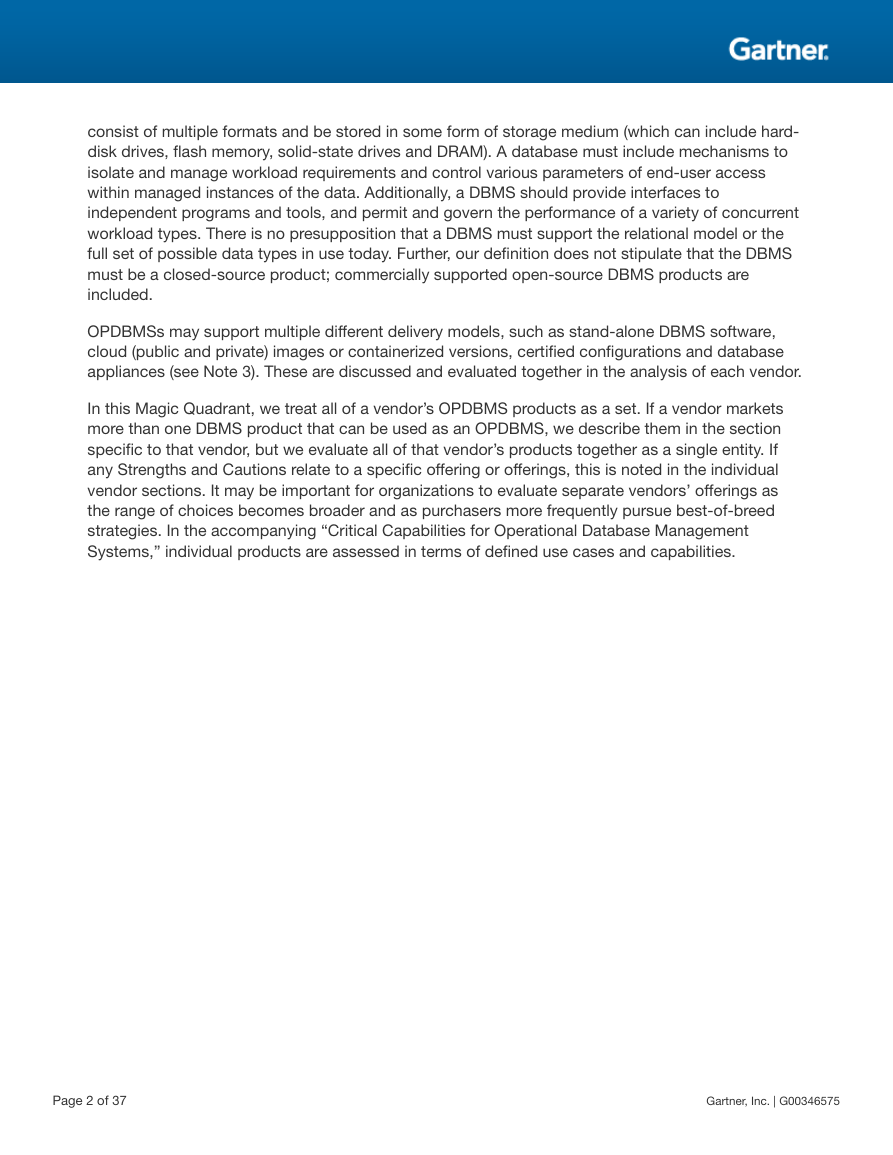
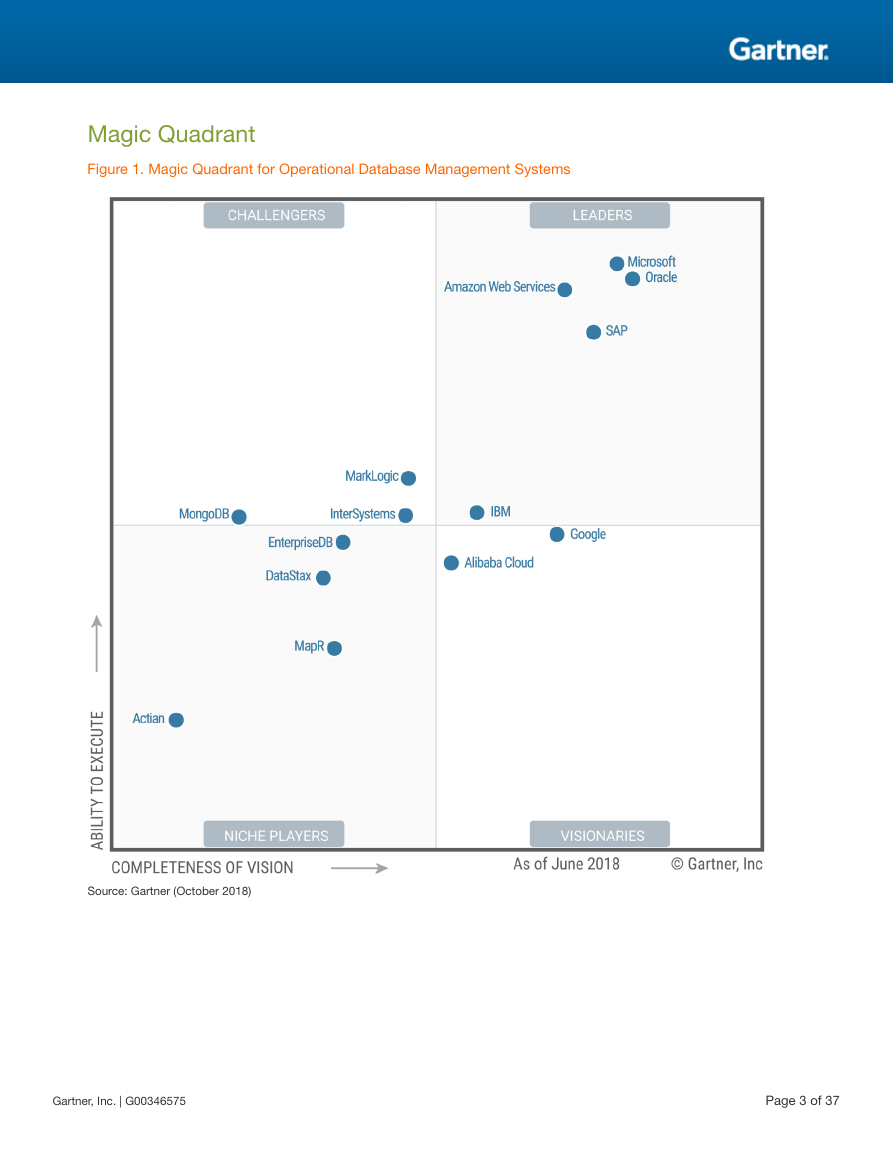
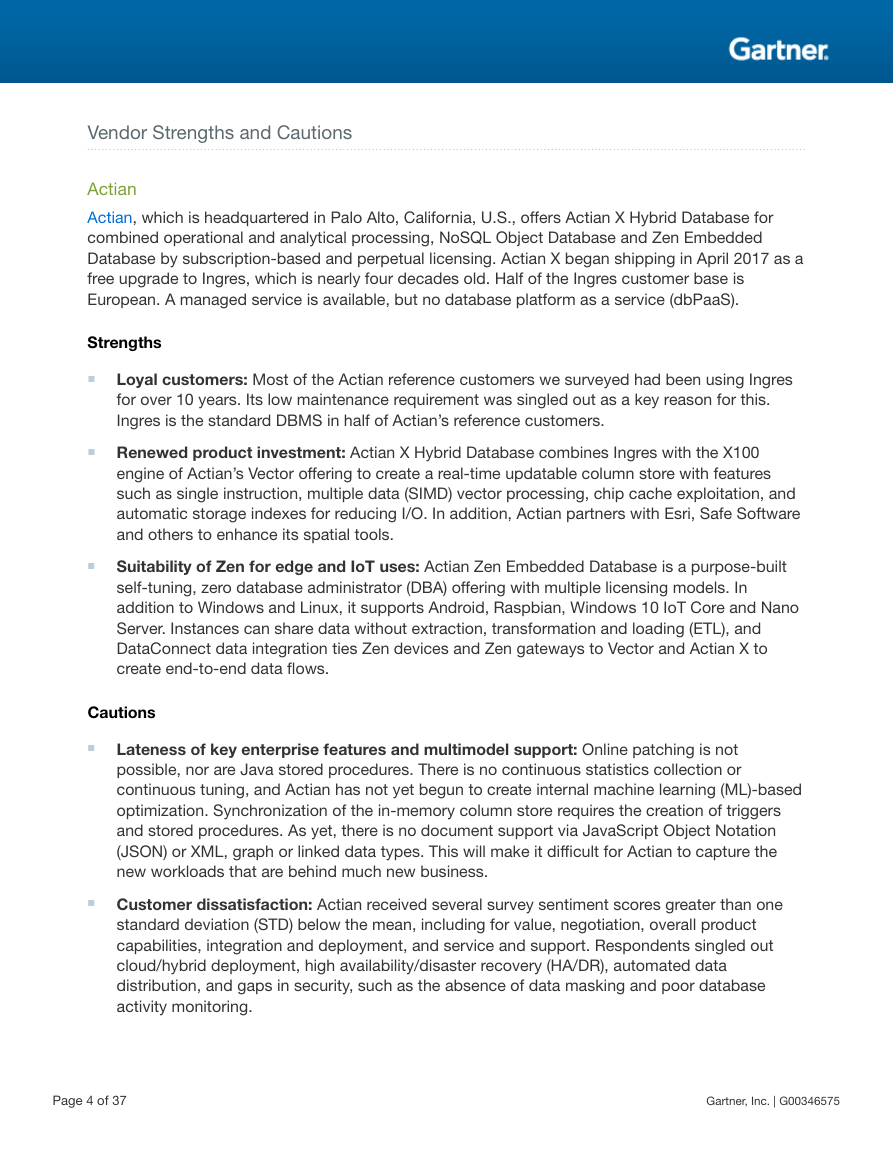

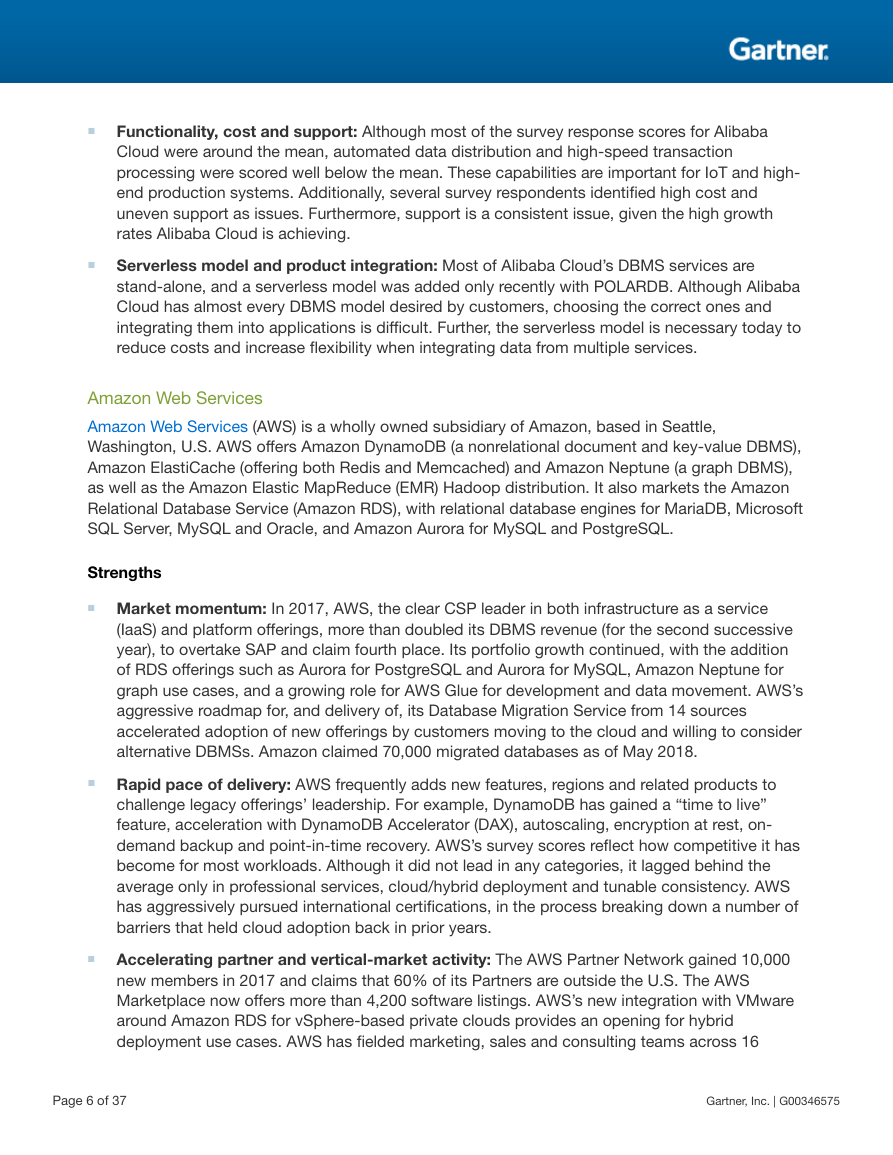
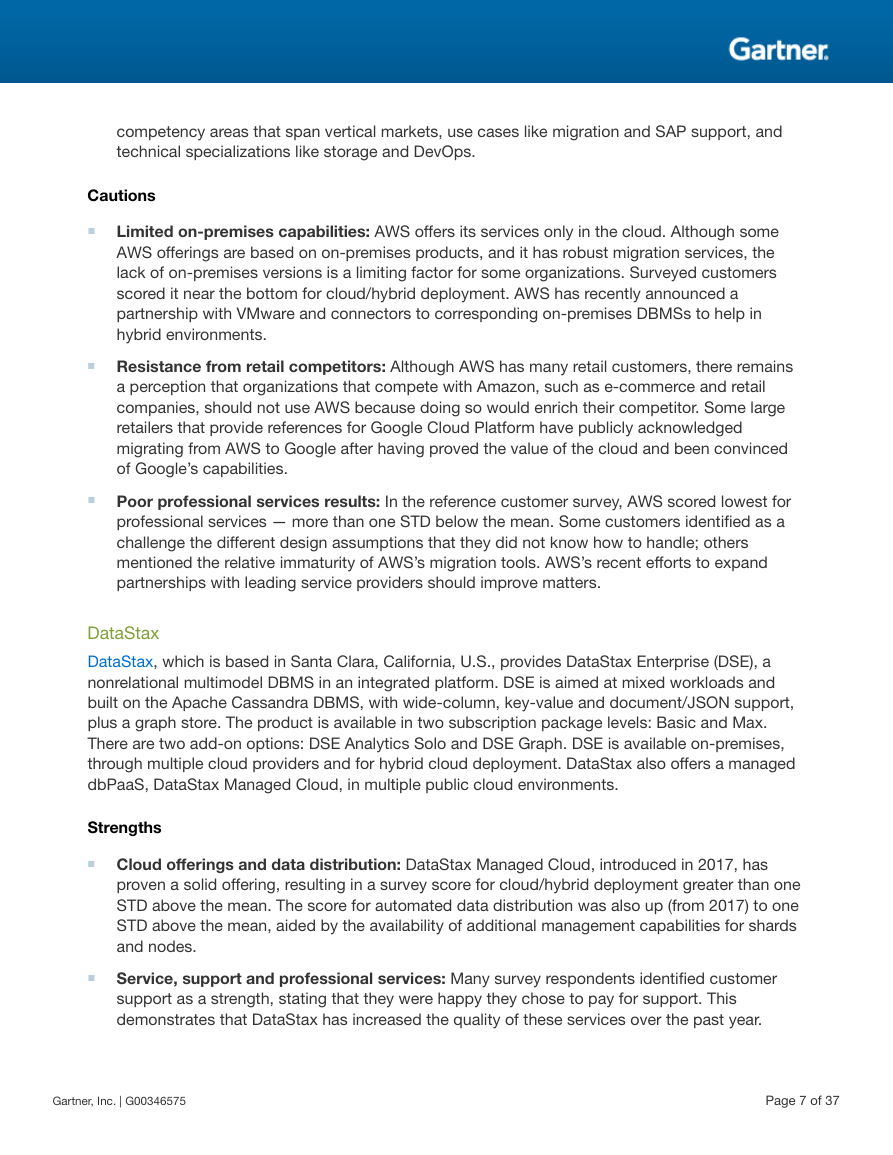
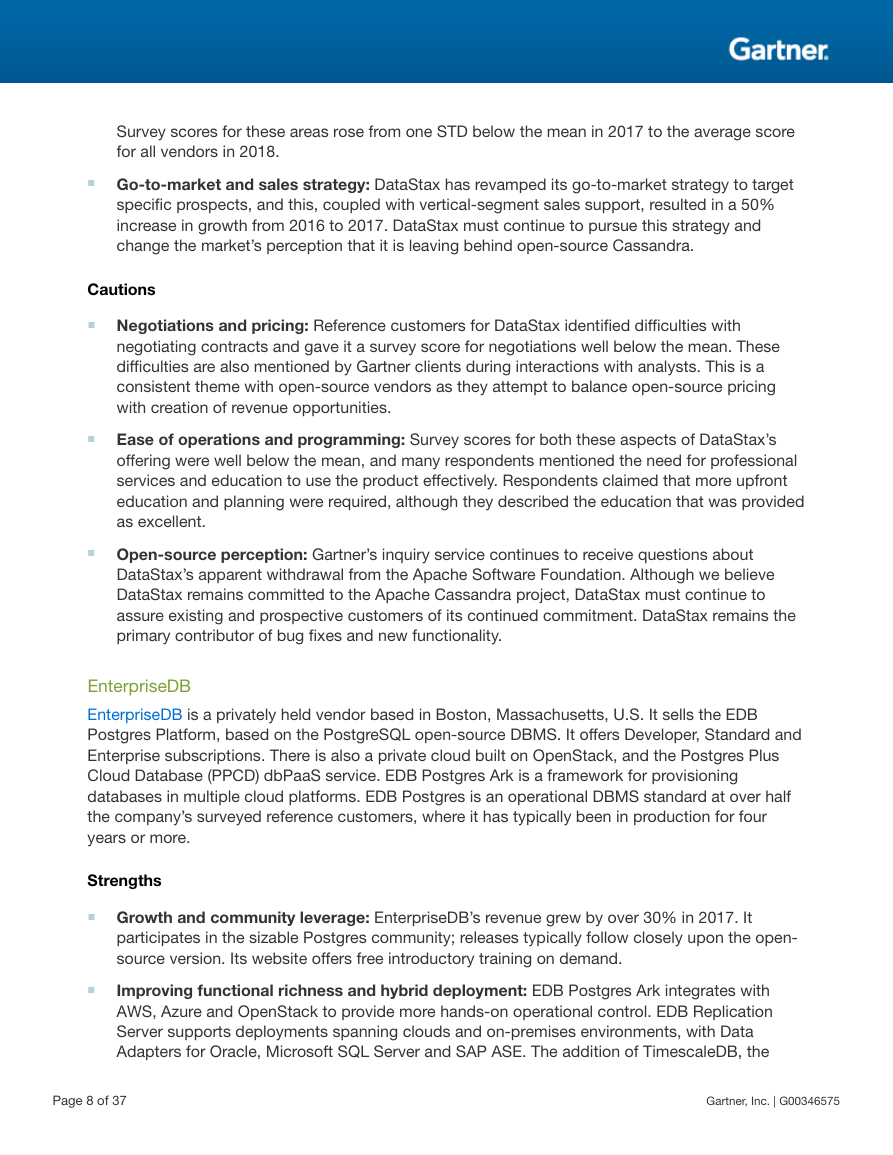








 2023年江西萍乡中考道德与法治真题及答案.doc
2023年江西萍乡中考道德与法治真题及答案.doc 2012年重庆南川中考生物真题及答案.doc
2012年重庆南川中考生物真题及答案.doc 2013年江西师范大学地理学综合及文艺理论基础考研真题.doc
2013年江西师范大学地理学综合及文艺理论基础考研真题.doc 2020年四川甘孜小升初语文真题及答案I卷.doc
2020年四川甘孜小升初语文真题及答案I卷.doc 2020年注册岩土工程师专业基础考试真题及答案.doc
2020年注册岩土工程师专业基础考试真题及答案.doc 2023-2024学年福建省厦门市九年级上学期数学月考试题及答案.doc
2023-2024学年福建省厦门市九年级上学期数学月考试题及答案.doc 2021-2022学年辽宁省沈阳市大东区九年级上学期语文期末试题及答案.doc
2021-2022学年辽宁省沈阳市大东区九年级上学期语文期末试题及答案.doc 2022-2023学年北京东城区初三第一学期物理期末试卷及答案.doc
2022-2023学年北京东城区初三第一学期物理期末试卷及答案.doc 2018上半年江西教师资格初中地理学科知识与教学能力真题及答案.doc
2018上半年江西教师资格初中地理学科知识与教学能力真题及答案.doc 2012年河北国家公务员申论考试真题及答案-省级.doc
2012年河北国家公务员申论考试真题及答案-省级.doc 2020-2021学年江苏省扬州市江都区邵樊片九年级上学期数学第一次质量检测试题及答案.doc
2020-2021学年江苏省扬州市江都区邵樊片九年级上学期数学第一次质量检测试题及答案.doc 2022下半年黑龙江教师资格证中学综合素质真题及答案.doc
2022下半年黑龙江教师资格证中学综合素质真题及答案.doc